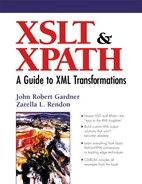Appendix A. Case Studies
This appendix provides examples that use many of the XPath and XSLT functions as well as the XSLT elements presented in this book. They are drawn directly, or otherwise derived, from real-world applications of XSLT. They have been chosen for their high likelihood of applicable relevance to most readers' needs. Each example is included on the CD.
There are many more uses of XSLT than are represented here. Be sure to review the examples of the <xsl:key> top-level element and key() function in Jeni Tennison's contributed Appendix B, “Grouping Using the Muenchian Method,” as well as the unique application of XSLT to the classic N-Queens problem in artificial intelligence, by Oren Ben-Kiki, in Appendix C.
In this appendix, we've included a sample of work with library records stored in the Machine Readable Record (MARC) format as part of a significant XML project currently underway at Emory University by the American Theological Library Association's Center for Electronic Resources in Theology and Religion. MARC records are an early standard for electronic card catalogues used for over 20 years by libraries around the world. In this example, MARC records converted to XML with an excellent shareware tool by Bob Pritchett at Logos Software (http://www.logos.com/marc/marc.asp) are mined for linking to individual images of each page of the journal article referenced by any given MARC record. Another example represents a common situation encountered with complex documents representing several types of markup DTDs and two different texts. It shows how to reformat the tags and separate the versions for selective publication.
The first set of examples represents a comprehensive range of ways to work with lists in XSLT and XPath to create HTML and plain text lists of varying formats and complexity.
